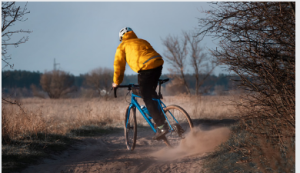Gravel bikes often feature drop bars instead of flat bars. Flat bars prevent the rider from reaching a more aerodynamic position and are less efficient on the road. Drop bars also give the rider a more comfortable position for their hands and cause less fatigue on long rides. For example, the Revolt series of bikes features a slightly flared drop handlebar for better hand positioning.
 Disc brakes
Disc brakes
Disc brakes are a great choice for gravel bikes because they provide consistent stopping power no matter what type of terrain you’re on. Because the traction on gravel roads isn’t nearly as consistent as on tarmac, it’s essential to have a reliable braking system that can apply power precisely. However, there are several things to consider when choosing brakes, including the type of pads you use.
Mineral oil is a safe option, as it doesn’t absorb water. But DOT fluid absorbs water, which can change its viscosity and cause it to feel spongy on the lever. It’s also not harmful to your skin, but you’ll need gloves when handling it, and it’s important to follow local regulations when disposing of it.
Disc brakes are the dominant brake system for gravel and cyclocross bikes. Even the most affordable bikes typically come with mechanical disc brakes. These brakes offer better control than rim brakes and aren’t affected by mud and water. The downside to disc brakes is that the tolerances can be tighter, which makes it more difficult to adjust. It can ruin a race, so paying attention to brake adjustments when riding a gravel bike is important.
Drop bars
Drop bars for Pushbikes gravel bikes NZ can add a lot of confidence to the riding experience. They improve the steering control and allow for more comfortable hand positions. You can find bars in various shapes, sizes, and materials, including heat-treated 7050 aluminium alloy, and this article will compare a few of the best bars for gravel bikes.
The width of a drop bar should be at least one inch wider than the handlebar’s width. It will allow the rider to dip lower and get more leverage for braking. In addition, you can choose between deep or shallow drops. Deeper drops will provide more leverage, while shallower ones will provide more height.
The shape of the drop bar is an important consideration for Pushbikes gravel bikes NZ. The modern versions of the drop bar have a less “hook” shape. As a result, it is more comfortable for the rider, as the hands will have the most leverage for the brake levers. The modern gravel bars are also less “hooky,” which makes them easier to transition into.
If you’re looking for a drop bar for gravel bikes, be sure to try it out before making a decision. Not only should the bar fit you comfortably, but it should be functional for your riding style. There are no two gravel bikes alike, so it’s important to find one that works best for you.
Long wheelbases
Compared to road bikes, gravel bikes have longer wheelbases, which are beneficial when riding on loose surfaces. This feature also makes gravel bikes more stable, particularly on long distances. They also typically have shorter stems and wider handlebars, which improve comfort and leverage. Lastly, gravel bikes are heavier than road bikes, so they are more durable. Many gravel bikes also have eyelets for mudguards, which can add protection and improve traction when cycling in muddy conditions.
Long-wheelbase gravel bikes can be a great option if you intend to do a lot of touring. They can handle hills, mud, and rough terrain. In addition, they can be configured with a wide range of gear for different types of riding. You can also buy models with extra spokes mounted along the chainstay.
The tires on gravel bikes are wider than those on road bikes. Because of this, they have a large amount of clearance. Many models can run 50mm-wide tyres. They are also designed to run at low pressures, which improves traction and comfort on rough surfaces. Choosing the right tyre for a gravel bike can make a huge difference in your enjoyment of the ride.
Large tires
When riding a gravel bike, the size of your tires matters. For the most part, you want to go with a tire that is big enough for the terrain you ride on but also provides good traction and a smooth ride. You also want to choose a puncture-resistant tire.
Comfortable
Comfortable gravel bikes should be stable, agile, and responsive to rider input without feeling uncomfortable or clumsy. Gravel bikes should also have a well-coordinated mix of geometry, weight distribution, and riding position. The bike’s torsional stiffness is also an important consideration.
Various brands and models of gravel bikes are available; many can be ridden in any weather. For instance, the Trek XC90 gravel bike has a Shimano GRX drivetrain, tubeless wheels, and a unique cockpit setup. It’s designed for gravel biking but performs well on tarmac and smooth single-track.
The Salsa Journeyer has a wide range of riders, and it’s a good option for beginners or seasoned riders alike. Its drivetrain includes SRAM Apex 1 components, and it has 11 gears. It also has mechanical disc brakes.
Easy to ride
Gravel bikes are suited for a wide range of cycling activities, from gentle off-road commuting to competitive cycling. These bikes are more agile than hybrid bikes and built with efficiency and safety in mind. As a result, they should be comfortable for long days in the saddle, light enough for after-work laps, and adaptable enough to handle multi-day adventures. And, of course, they should be stylish.
A gravel bike should be stable and agile and respond well to pedal input. It should also be easy to work on and maintain. In addition, it should have well-coordinated weight distribution, geometry, and torsional stiffness. These features are crucial to the comfort and safety of gravel riders and can make or break a bike.